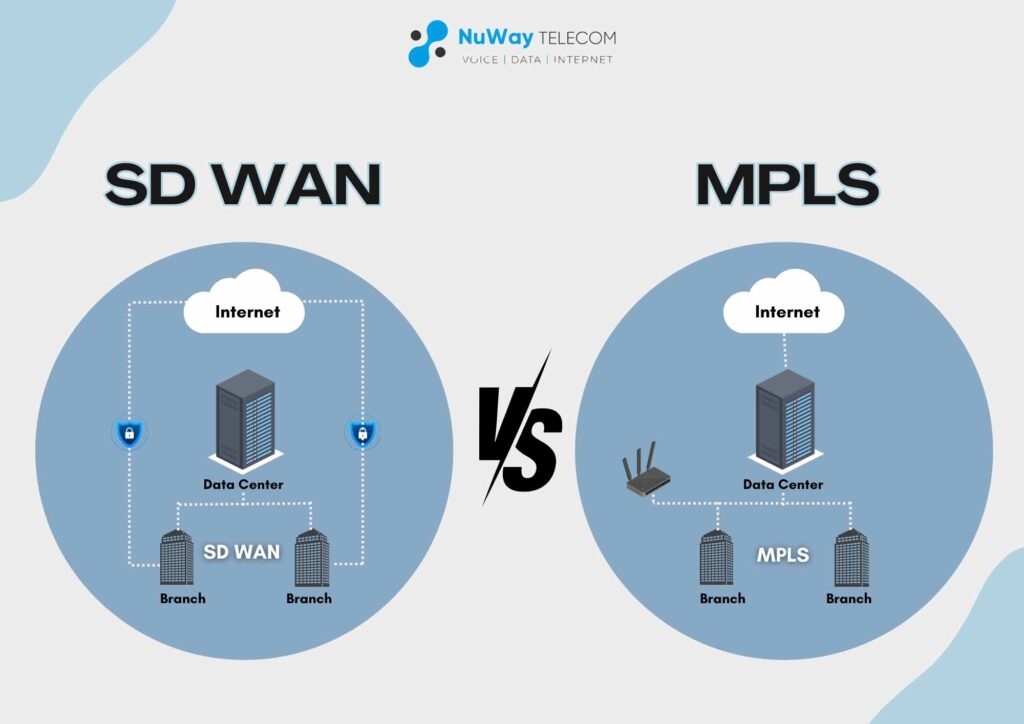
MPLS, which stands for Multiprotocol Label Switching, and SD-WAN, or Software-Defined Wide Area Network, are unique network technologies. Both have a significant function in today’s options for connecting networks. Organizations must grasp the characteristics, benefits, and potential challenges of MPLS or SD-WAN to improve their network systems.
MPLS has been the typical method for safe and solid data transmission, while SD-WAN provides flexibility and cost-effectiveness because of software-defined networking. Understanding the dissimilarities in these technologies is helpful for businesses when deciding on their network structures. This article gives a general understanding of MPLS and SD-WAN, contrasting their characteristics, advantages, and compatibility with various organizational requirements.
How Does MPLS Routing Work?
MPLS routing assigns packet labels, which helps fast-forward data along fixed paths. When a packet enters the MPLS network, its label leads it to a route. Routers create tables for forwarding and add these labels to the packet’s head to assist with quick and predictable routing. MPLS routers use the labels to decide where to send packets; they don’t look inside them.
This method helps speed up network traffic and improve performance. It is very suitable for companies that need stable connections with less delay time. MPLS manages data transfer smartly by giving priority according to labels, which helps handle complex networks without difficulty.
What is an MPLS circuit?
An MPLS circuit is a virtual connection formed in an MPLS network. It lets devices at different ends of the network talk to each other. Label-switched paths (LSPs) are not the same as regular circuits. LSPs are logical routes that are created using label-switching technology. They are not physically existing circuits.
Every MPLS circuit has its unique ID, which routers can use to guide traffic along this specific pathway according to their pre-set routing policies. MPLS circuits provide a particular bandwidth and assurance for QoS (Quality of Service). They ensure that data transmission is dependable and predictable.
SD-WAN vs. MPLS

When we compare MPLS vs. SD-WAN, it becomes clear that each has its advantages and considerations for network infrastructure. People recognize MPLS for its reliability and security. It offers deterministic routing and quality of service (QoS) guarantees, which are the perfect choice for mission-critical applications. However, MPLS can be costly and not very flexible when adjusting to changing traffic routes.
On the other hand, SD-WAN uses software-defined networking to change traffic paths on many transport links. It offers flexibility, money-saving, and routing that is aware of applications. Although SD-WAN is very flexible and inexpensive, it might need to be more reliable or have the same quality of service as MPLS.
Can SD-WAN Replace MPLS?
If SD-WAN can fully take over, MPLS relies on what an organization wants and values most. Although SD-WAN provides flexibility, cost reduction, and routing based on applications, MPLS offers reliability, safety, and deterministic routing. Most of the time, organizations choose a combination of both technologies to benefit from their strong points.
SD-WAN can work with MPLS by moving non-important traffic onto broadband connections and keeping MPLS for latency-sensitive or very important applications. Yet, certain businesses might still depend on MPLS due to strict performance needs or compliance requirements.
Benefits of SD-WAN Compared to MPLS
SD-WAN offers several advantages compared to MPLS: Transportation with a network of airlines will allow you to fly solo or in groups and even send more oversized shipments in the most appropriate conditions; air travel will be flexible, economical, and highly manageable.
SD-WAN, in turn, employs an array of transport links, such as wide-area internet connectivity, and thereby assists in providing better traffic issue management by cutting down the demand for costly MPLS liaisons.
Also, SD-WAN’s central management and automation abilities simplify network operations, making it possible to set up the system more quickly and make configuration modifications.
SD-WAN vs. MPLS Feature Comparison
When we look at the features of SD-WAN and MPLS, they show apparent differences in strengths and things to consider. The deterministic routing, quality of service (QoS) assurances, and robust security measures provided by MPLS are perfect for applications that need this type of reliability and performance predictability on a mission-critical level.
However, due to its high-cost structure, it could be more flexible and adaptable when dealing with changing traffic patterns. On the other hand, SD-WAN offers flexibility with its benefits in using broadband, cost savings, and centralized control. It makes it possible to set up and adjust configurations quickly.
Is MPLS more expensive than SD-WAN?
The comparison of costs between MPLS and SD-WAN is complex. It depends on many elements, like the network size, bandwidth you require, and the features desired in your system. Usually, MPLS costs start generating when dedicated circuits and equipment are needed to function.
MPLS providers also charge according to how much you use their service or the distance between locations. MPLS typically needs unique and costly links between locations, increasing the initial investment for organizations.
In contrast, SD-WAN can use existing internet connections, lessening the need for high first-time costs and potentially bringing savings in ongoing expenses.
Is MPLS still used?
Certainly! Not only does MPLS (Multiprotocol Label Switching) remain popular among several enterprise networks, but it also dominates in many other sectors. SD-WAN is the most popular super-optimized Wide-area network (MPLS) that has emerged. However, organizations with such requirements have used it.
This technology provides predictable routing and quality of service. Its robust security features make it suitable for applications like voice transmission, video, and data services. SD-WAN is more useful as an MPLS replacement because it offers flexibility and financial enhancements; moreover, it only partially replaces MPLS.
Which Connectivity Option Is Right for Your Organization?
Choosing a connectivity option for your organization depends on various elements. These include performance needs, budget limitations, and the desired level of control. If the business depends strongly on mission-critical applications that need high reliability and performance predictability, MPLS can be more suitable, even with its more significant cost.
Conversely, if flexibility, scalability, and cost-effectiveness are vital concerns, SD-WAN might offer a better solution, particularly for organizations with numerous branches or those operating mainly in the cloud.
Choose NuWay TELECOM for a reliable and cost-effective option that combines Multiprotocol Label Switching reliability with SD-WAN flexibility. It is an optimal choice for organizations seeking both performance and scalability.

Recent Comments